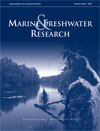Marine and Freshwater Research
Volume 64
Number 3 2013
This research provides first life-history information for CITES-listed tropical seahorses, fished for use as traditional medicine, as ornamentals and as curiosities. Using field and analytical methods, we found that Hippocampus comes is an intermediate life-history strategist that settles at ~3cm, grows rapidly, matures at 9.3cm and lives ≥2.5 years. Reference points from this work will be useful for management of this charismatic, but data-poor genus.
Q: When is a connection not a connection? A: When it is a crinkled link. Connectivity among marine populations is crinkled when they are genetically but not demographically linked. Quantifying these types of linkages would provide additional valuable information for fisheries management.
We aimed to assess agricultural impacts on biodiverse Wet Tropics floodplain lagoons. We found that invertebrate assemblages were influenced more by habitat (weed invasion, loss of riparian vegetation) than water quality impacts, because of the dilution afforded by regular flushing. We demonstrated that inferences regarding ecosystem health were possible despite having few replicate and no reference sites.
Sexual carp gudgeons coexist with hybrid unisexual carp gudgeons that reproduce by ‘parasitising’ sperm and eggs of the sexual species; a process that can lead to extinction of subpopulations. This study used genetic data to show that structuring of a sexually reproducing carp gudgeon population is consistent with spatially constrained metapopulation dynamics. Metapopulation dynamics are one mechanism that may contribute to coexistence between the sexual and unisexual taxa.
Understanding the upstream spawning migration of diadromous fishes is critical to effective conservation and management of these species. The diet of spawning individuals of twaite shad, Alosa fallax, remains poorly understood and some researchers consider that A. fallax does not feed actively during the upstream migration; however, this study demonstrates that at least some specimens do. In fact, this paper is the first record of this species feeding on potamodromous fishes during the upstream migration and, therefore, the question remains whether this phenomenon represents a benefit or evolutionary advantage for those individuals.
Attendance and by-catch of marine top predators in coastal pair-trawl fisheries at Mar del Plata, Argentina is described. Two gull species, the kelp gull Larus dominicanus and the Olrog’s gull L. atlanticus, dominated the assemblages; an estimated 84 Magellanic penguins Spheniscus magellanicus may be killed annually in the mid-water fishery. This by-catch should be placed in the wider context of other impacts on Magellanic penguin populations in Patagonia.
Rhinogobius is a species-rich freshwater fish genus that embraces a diversity of habitats and migration patterns. In this study, eggs and larvae of three species from Okinawa, Japan, were reared under uniform conditions to compare their larval development. Differences in larval traits and developmental events explain specific habitat preferences and migration patterns, and provide insights into the speciation process
Marine diseases threaten wild organisms, yet studies often only consider impacts among aquacultured animals. In an estuary of eastern Australia we discovered that disease, and mortality among wild oysters was comparatively lower than among aquacultured counterparts. Our study showed that diseases of aquaculture stocks may infect wild populations, and that longer-term assessment of wild populations at risk is essential.




